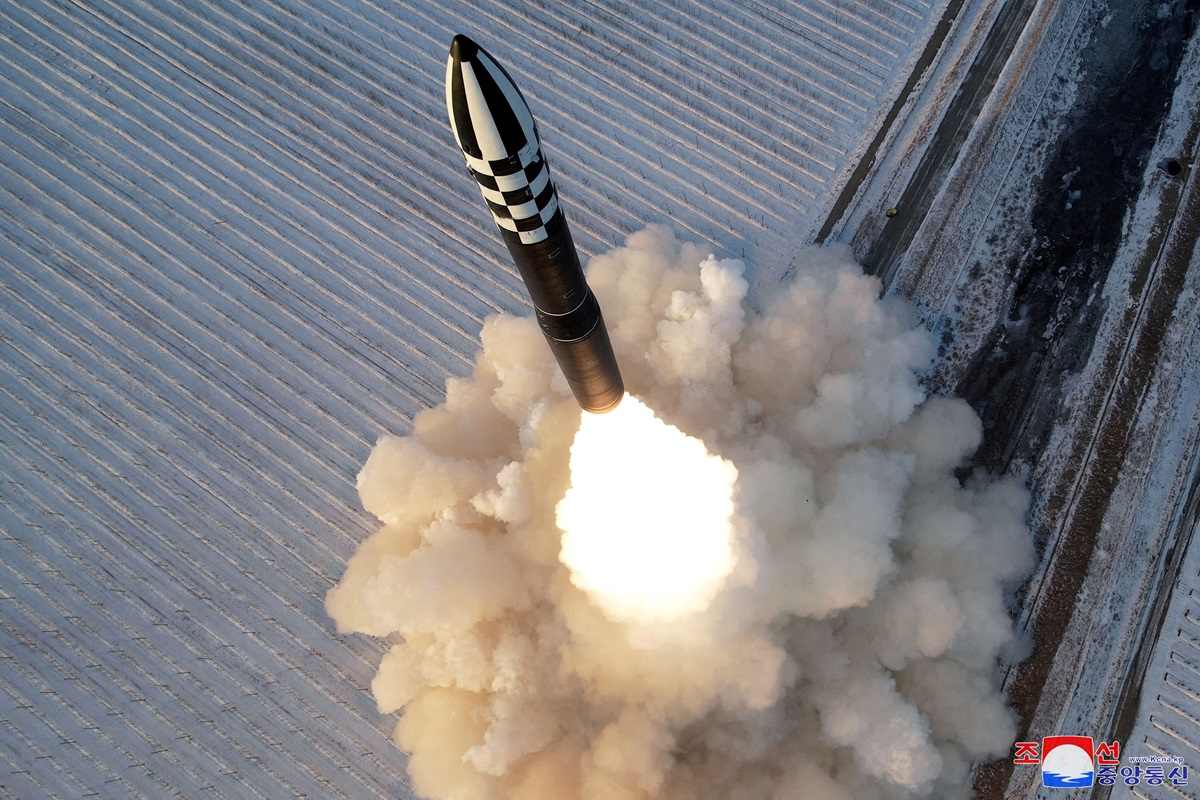
A Hwasong-18 intercontinental ballistic missile is launched during what North Korea says is a drill at an unknown location Dec. 18, 2023 in this picture released by the Korean Central News Agency.
11:13 JST, November 1, 2024
SEOUL (Reuters) – North Korea flexed its military muscle with the test of a huge new solid-fuel intercontinental ballistic missile dubbed Hwasong-19, state media said on Friday, amid international uproar over its troops deployed to aid Russia in Ukraine.
The launch on Thursday flew higher than any previous North Korean missile, according to the North as well as militaries in South Korea and Japan that tracked its flight deep into space before it splashed down in the ocean between Japan and Russia.
State news agency KCNA lauded it as “the world’s strongest strategic missile.”
While questions remain over North Korea’s ability to guide such a missile and protect a nuclear warhead as it reenters the atmosphere, the Hwasong-19, like North Korea’s other latest ICBMs, demonstrated the range to strike nearly anywhere in the United States.
“The new-type ICBM proved before the world that the hegemonic position we have secured in the development and manufacture of nuclear delivery,” leader Kim Jong Un said while overseeing the launch, KCNA reported.
Thursday’s missile launch, just days before next week’s pivotal U.S. presidential election, drew swift condemnation from Washington and its allies in South Korea, Japan and Europe, as well as the United Nations Secretary-General.
Ukraine’s President Volodymyr Zelenskiy blasted what he called his allies’ “zero” response to Russia’s deployment of North Korean troops for the war in Ukraine, which has also sparked worries that Moscow could provide sensitive military technology to Pyongyang in return.
Russia and North Korea have not denied the troop deployments, and defended their right to help each other.
Defense Secretary Lloyd Austin said the Pentagon was very early in its assessment phase of the missile launch “and we don’t see any indication at this point that there was Russian involvement.”
The KCNA report said the launch did not affect the safety of neighbouring countries and it was an appropriate military step in the face of threats from North Korea’s enemies.
The Hwasong-19 will deploy alongside the Hwasong-18, which was first launched last year and is also powered by solid fuel, KCNA said.
Solid-fuel missiles do not need to be fuelled immediately ahead of launch, are often easier and safer to operate, and require less logistical support, making them harder to detect than liquid-fuel weapons.
Photos released by KCNA showed a large, multi-stage missile launched from a canister carried by a transporter-erector-launcher (TEL) vehicle.
KCNA also showed photos from cameras that appeared to be attached to the missile, taking images of stage separations and the earth.
The missile flew the distance of 1,001.2 km (622.12 miles) for 5,156 seconds before landing in the sea off the east coast of the Korean peninsula, according to the KCNA report.
It recorded a maximum peak altitude of 7,687.5 km (4,776.79 miles), it added.
"News Services" POPULAR ARTICLE
-

American Playwright Jeremy O. Harris Arrested in Japan on Alleged Drug Smuggling
-

Japan’s Nikkei Stock Average as JGB Yields, Yen Rise on Rate-Hike Bets
-

Japan’s Nikkei Stock Average Licks Wounds after Selloff Sparked by BOJ Hike Bets (UPDATE 1)
-

Japan’s Nikkei Stock Average Buoyed by Stable Yen; SoftBank’s Slide Caps Gains (UPDATE 1)
-

Japanese Bond Yields Zoom, Stocks Slide as Rate Hike Looms
JN ACCESS RANKING
-

Tokyo Economic Security Forum to Hold Inaugural Meeting Amid Tense Global Environment
-

Keidanren Chairman Yoshinobu Tsutsui Visits Kashiwazaki-Kariwa Nuclear Power Plant; Inspects New Emergency Safety System
-

Imports of Rare Earths from China Facing Delays, May Be Caused by Deterioration of Japan-China Relations
-

University of Tokyo Professor Discusses Japanese Economic Security in Interview Ahead of Forum
-

Japan Pulls out of Vietnam Nuclear Project, Complicating Hanoi’s Power Plans
























